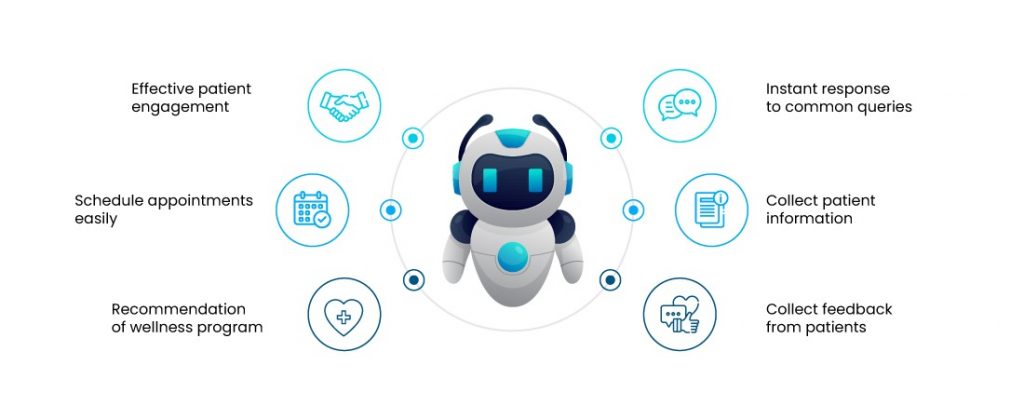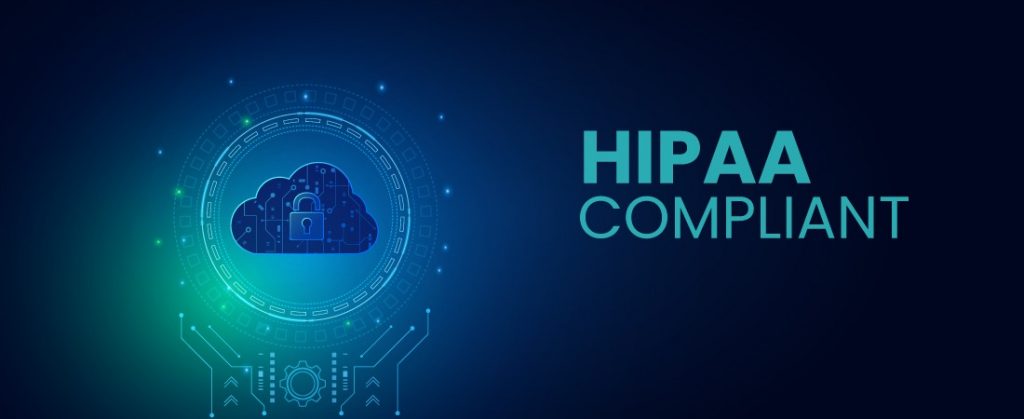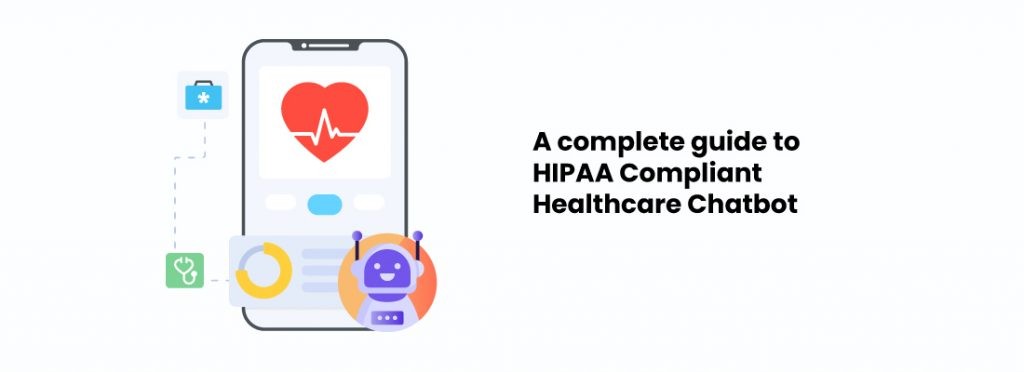HIPAA-compliant healthcare chatbot: Modern technological developments have completely transformed the healthcare sector, improving patient care, information access, and overall effectiveness.
One such innovation is the creation of chatbots, automated conversational agents that can help and communicate with users in an array of contexts.
Chatbots have become useful tools in the healthcare industry, helping patients and healthcare providers communicate more easily by responding to questions quickly and efficiently.
However, the security of private patient data is of utmost significance in the healthcare industry.
To preserve patient privacy and guarantee the confidentiality, integrity, and accessibility of electronically protected health information (ePHI), the Health Insurance Portability and Accountability Act (HIPAA) was created in the United States.

Data Encryption
Encryption is an essential part of protecting PHI transmitted or stored by a medical chatbot.
It makes sure that even if data is intercepted, unauthorized people cannot view or use it.
To encrypt data during transmission, the chatbot should employ robust encryption protocols like Transport Layer Security (TLS) or Secure Sockets Layer (SSL).
To prevent unauthorized access, all PHI held in databases or other storage systems should be encrypted.
Access Controls
Access controls are tools that only provide authorized people access to PHI.
To guarantee that only authorized users, such as healthcare professionals, have access to PHI, the chatbot should apply strict access control methods.
Confirm users’ identities, this entails integrating user authentication procedures like username/password combinations, two-factor authentication, or biometric authentication.
Depending on the user’s job and responsibilities, multiple levels of access can be granted using role-based access control (RBAC).
To make sure that user access privileges adhere to the principle of least privilege, it is crucial to routinely examine and update them.
Audit Records
Audit logs are essential for keeping track of and spotting unauthorized access to or violations of PHI.
The chatbot ought to keep thorough logs of all user communications, including access to PHI.
These logs frequently contain data such as user IDs, timestamps, and specifics of the actions taken.
System administrators can spot any unusual activity and take immediate action in the event of a security problem by routinely monitoring audit logs.
Secure Hosting and Infrastructure
The chatbot’s infrastructure and hosting environment should be created with strong security measures.
This involves using physical security measures to prevent unauthorized access to servers and other network equipment.
To track and stop unauthorized network access, firewalls, and intrusion detection systems must be installed.
To fix any known vulnerabilities, routine security upgrades, and patch management should be carried out.
To guarantee the security and integrity of the chatbot’s infrastructure, the hosting provider should follow industry best practices and compliance standards.
Business Associate Agreement (BAA)
A Business Associate Agreement (BAA), which regulates the use and protection of PHI, is a legally binding agreement between a covered entity (such as a healthcare provider) and a business associate (such as the chatbot provider).
A BAA must be in place if the chatbot provider manages PHI on behalf of a covered entity.
The BAA specifies the chatbot provider’s obligations about protecting PHI, including specifications for security precautions, breach notification, and limitations on PHI use and communication.
It guarantees that the company providing the chatbot is aware of its HIPAA requirements and gives guarantees that it will handle PHI in a compliant way.
PHI Handling
To lower the risk of data exposure, the chatbot should be built to collect, store, and retain PHI as little as possible.
It should only gather the data required to deliver healthcare services and achieve its intended goals.
When possible, unnecessary PHI should be avoided or de-identified.
The chatbot should use the previously described encryption techniques to keep any gathered PHI securely and put in place safeguards to thwart unauthorized access, like strict access controls.
PHI must be securely disposed of when it is no longer required in compliance with HIPAA guidelines to prevent unauthorized access or exposure.
Authorization and User Consent
The chatbot should have the necessary user consent and authorization before collecting, storing, or sharing any PHI.
This guarantees that users are fully aware of how their PHI will be used and have provided their express consent to its treatment.
The consent procedure must adhere to HIPAA regulations and be open and simple to understand.
It should expressly outline the PHI’s intended uses, potential disclosures, and the user’s rights concerning their data.
Before starting any data collection or sharing operations, the chatbot should get users’ approval.
It should also offer users ways to withdraw their consent at any time.
Policies and Training
To make sure that they comprehend the rules and their obligations in handling PHI, the chatbot provider should train their staff on HIPAA compliance.
”This involves teaching employees about the safe utilization of the chatbot, data privacy procedures, as well as how to respond to possible security incidents.
The provider should also create and keep up-to-date written policies and guidelines that include HIPAA compliance, PHI handling, security precautions, breach response, and other pertinent issues.
To guarantee continuing compliance and adherence to best practices, these rules should be frequently reviewed, updated, and publicized.
FAQs
How can a HIPAA-compliant healthcare chatbot gain medical care organizations?
Implementing a HIPAA-compliant healthcare chatbot can improve the patient experience by streamlining administrative procedures, increasing patient interaction, and other areas.
What features can a HIPAA-compliant healthcare chatbot offer?
A HIPAA-compliant healthcare chatbot can do a variety of tasks, including responding to user requests for information, giving health advice, assisting with appointment scheduling, providing basic triage support, and pointing users toward pertinent resources. The chatbot uses machine learning and natural language processing to deliver precise and individualized responses in a conversational style.

Final thoughts
In conclusion, a HIPAA-compliant healthcare chatbot offers a safe and effective way to connect patients and medical professionals.
These chatbots provide a useful tool to improve patient care while protecting the privacy and security of sensitive patient information by maintaining compliance with HIPAA rules.
Healthcare organizations can enhance patient engagement, speed up administrative procedures, and lessen the workload on staff by installing a HIPAA-compliant healthcare chatbot, allowing them to concentrate on more difficult and crucial healthcare jobs.







